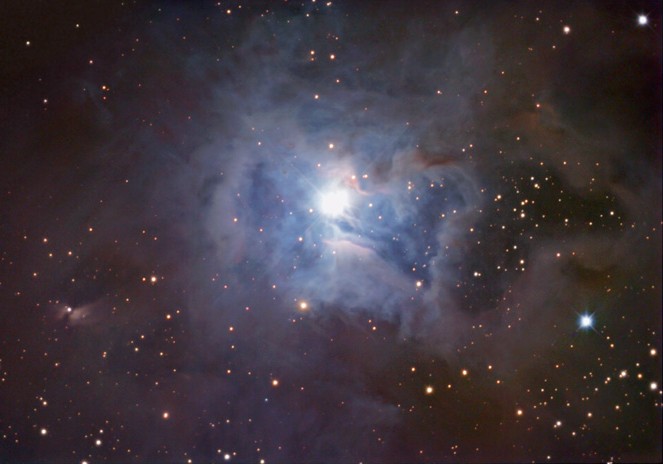Credit & Copyright: Image - Jim Misti
(acquisition),
Robert Gendler
(processing)
Explanation:
Like delicate cosmic petals, these clouds of interstellar
dust and gas have blossomed 1,300 light-years away in the fertile
star fields of the constellation Cepheus.
Sometimes called the Iris Nebula and dutifully
cataloged as NGC
7023, this is not the only nebula in the
sky to evoke the imagery of flowers.
Still, the
beautiful
digital image shows off the Iris Nebula's range of colors and
symmetries in impressive detail.
Within the Iris, dusty nebular material surrounds a massive, hot,
young star in its formative years.
Central filaments of cosmic dust glow with a reddish photoluminesence
as some dust grains
effectively
convert the star's invisible
ultraviolet
radiation to visible red light.
Yet the dominant color of the nebula is blue,
characteristic
of dust grains reflecting starlight.
Dark, obscuring clouds of dust and cold molecular gas are also
present and can lead the eye to see other
convoluted and
fantastic shapes.
Infrared observations
indicate that this nebula may contain
complex carbon molecules known as
PAHs.
As shown here, the Iris Nebula is about 6 light-years across.
1999 2000 2001 2002 2003 2004 2005 2006 2007 2008 2009 2010 2011 2012 2013 2014 2015 2016 2017 2018 2019 2020 2021 2022 2023 2024 2025 |
Yanvar' Fevral' Mart Aprel' Mai Iyun' Iyul' Avgust Sentyabr' Oktyabr' Noyabr' Dekabr' |
NASA Web Site Statements, Warnings, and Disclaimers
NASA Official: Jay Norris. Specific rights apply.
A service of: LHEA at NASA / GSFC
& Michigan Tech. U.
|
Publikacii s klyuchevymi slovami:
otrazhatel'nye tumannosti - reflection nebula - emission nebula - dark nebula - Tumannost' Iris - NGC 7023 - temnaya tumannost' - emissionnaya tumannost'
Publikacii so slovami: otrazhatel'nye tumannosti - reflection nebula - emission nebula - dark nebula - Tumannost' Iris - NGC 7023 - temnaya tumannost' - emissionnaya tumannost' | |
Sm. takzhe:
Vse publikacii na tu zhe temu >> | |
